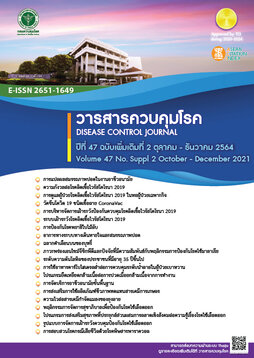Longitudinal assessment of pulmonary function change over time in occupational health setting
DOI:
https://doi.org/10.14456/dcj.2021.97คำสำคัญ:
Longitudinal normal limit, Spirometry, Health surveillanceบทคัดย่อ
การตรวจสมรรถภาพปอดเป็นส่วนหนึ่งของการตรวจสุขภาพตามปัจจัยเสี่ยงเพื่อเฝ้าระวังภาวะทางสุขภาพสำหรับผู้ที่สัมผัสสิ่งคุกคามทางสุขภาพทางระบบทางเดินหายใจ โดยมีจุดประสงค์เพื่อตรวจคัดกรองหาความผิดปกติของโรคทางระบบทางเดินหายใจได้ตั้งแต่ระยะแรกเริ่มโดยที่ยังไม่มีอาการผิดปกติ ซึ่งจะเป็นประโยชน์อย่างยิ่งต่อสถานประกอบกิจการในการเฝ้าระวังผลกระทบต่อสุขภาพของลูกจ้างที่ทำงานสัมผัสกับปัจจัยเสี่ยงและใช้ประเมินประสิทธิภาพของมาตรการป้องกันที่ดำเนินการมา ในประเทศไทยนั้นพบว่ามีสถิติจำนวนผู้เข้ารับการตรวจเพื่อวินิจฉัยโรคจากการทำงานในกลุ่มของโรคทางระบบทางเดินหายใจ เช่น โรคปอดจากแร่ใยหิน โรคปอดฝุ่นหิน และโรคหืดจากการทำงานน้อยมากเมื่อเทียบกับสัดส่วนประชากรที่ทำงานในภาคอุตสาหกรรมของประเทศ ซึ่งอาจเกิดจากประเทศไทยยังไม่ได้กำหนดมาตรฐานหรือแนวทางในการแปลผลค่าสมรรถภาพปอดเพื่อติดตามการเปลี่ยนแปลงและเฝ้าระวังผลกระทบทางสุขภาพของสมรรถภาพปอดในระยะยาว ส่งผลให้แพทย์หรือบุคคลากรทางสุขภาพในงานอาชีวอนามัยนั้นไม่สามารถทำการตรวจติดตามและวินิจฉัยโรคทางระบบทางเดินหายใจได้อย่างมีประสิทธิภาพ ในปัจจุบันวิทยาลัยอาชีวเวชศาสตร์และเวชศาสตร์สิ่งแวดล้อมประเทศสหรัฐอเมริกาได้มีการแนะนำแนวทางในการแปลผลค่าสมรรถภาพปอดเพื่อติดตามการเปลี่ยนแปลงในระยาวในงานอาชีวอนามัย ทำให้สามารถตรวจพบการลดลงของค่าสมรรถภาพปอดที่มีนัยสำคัญได้ตั้งแต่ในระยะเริ่มแรกซึ่งมีประโยชน์อย่างยิ่งสำหรับประเทศไทยในการนำแนวทางนี้มาใช้เพื่อการเฝ้าระวังผลกระทบต่อภาวะสุขภาพให้กับลูกจ้างที่ทำงานสัมผัสกับปัจจัยเสี่ยงทางด้านสารเคมีที่ส่งผลกระทบต่อระบบทางเดินหายใจ
Downloads
เอกสารอ้างอิง
Omland Wrtz ET, Aasen TB, Blanc P, Brisman J, Miller MR, et al. Occupational chronic obstruc¬tive pulmonary disease: a systematic literature review. Scand J Work Environ Health. 2014 ;1:19-35.
Health and Safety Executive. Occupational Lung Disease statistics in Great Britain 2020 [Inter¬net]. Annual statistic; 2020 [cited 2021 Jul 7]. Available from: https://www.hse.gov.uk/statis¬tics/causdis/respiratory-diseases.pdf
Health and Safety Executive. Occupational Lung Disease statistics in Great Britain. Annual statis¬tic. United Kingdom: Health and Safety Execu¬tive; 2021. p. 2-13.
De Matteis S, Heederik D, Burdorf A, Colosio C, Cullinan P, Henneberger PK, et al. Current and new challenges in occupational lung diseases. Eur Respir Rev. 2017;146:26.
Pellegrino R, Viegi G, Brusasco V, Crapo RO, Burgos F, Casaburi RE, et al. Interpretative strategies for lung function tests. Eur Respir j. 2005;26(5):948-68.
Meredith SK, Taylor VM, McDonald JC. Occupational respiratory disease in the United Kingdom 1989: a report to the British Thoracic Society and the Society of Occupational Medicine by the SWORD project group. Int J Occup Environ Med. 1991;48(5):292-7.
Meyer JD, Holt DL, Chen Y, Cherry NM, McDonald JC. SWORD’99: surveillance of work‐related and occupational respiratory disease in the UK. Occup med (Lond). 2001;51 (3):204-8.
Lai PS, Christiani DC. Long term respiratory health effects in textile workers. Current opinion in pulmonary medicine. 2013;19(2):152.
Redlich CA, Tarlo SM. Longitudinal assessment of lung function decline in the occupational setting. Curr Opin Allergy Clin Immunol. 2015; 15(2):145-9.
Lewis L, Fishwick D. Health surveillance for occupational respiratory disease. Occup med (Lond). 2013;63(5):322-34.
Hayes D, Kraman SS. The physiologic basis of spirometry. Respir Care. 2009;54(12):1717-26.
Wilken D, Baur X, Barbinova L, Preisser A, Meijer E, Rooyackers J, Heederik D. What are the benefits of medical screening and surveil¬lance?. Eur Respir Rev. 2012;21(124):105-11.
Szram J, Cullinan P. Medical surveillance for prevention of occupational asthma. Curr Opin Allergy Clin Immunol. 2013;13(2):138-44.
Graham BL, Steenbruggen I, Miller MR, Barjaktarevic IZ, Cooper BG, Hall GL, et al. Standardization of spirometry 2019 update. An official American thoracic Society and European respiratory Society technical statement. Am J Respir Crit Care Med. 2019;200(8):e70-88.
The Association of Occupational and Environ¬mental Diseases of Thailand and Occupational and Environmental Medical Center, Nopparat Rajathanee Hospital. Guideline for standardization and interpretation of pulmonary function test by spirometry in occupational health setting 2014 version. Bangkok: Nopparat Rajathanee Hospital; 2014.
Thoracic Society of Thailand under Royal Patronage. Spirometry interpretation training book for authorities. Bangkok: Thoracic Society of Thailand under Royal Patronage; 2013.
Dreger M. Spirometry in Occupational Health—2020. Journal of occupational and envi¬ronmental medicine. 2020;62(5):e208-30.
Occupational Safety and Health Administration. Spirometry Testing in Occupational Health Programs. Best Practices for Healthcare Profes¬sionals. Osha 3637-03 2013. Washington, DC: OSHA; 2013.
Townsend MC, Occupational and Environmental Lung Disorders Committee. Spirometry in the occupational health setting 2011 update. Journal of occupational and environmental medicine. 2011;53(5):569-84.
Lee PN, Fry JS. Systematic review of the evidence relating FEV1 decline to giving up smoking. BMC Med. 2010;8(1):1-29.
Ryan G, Knuiman MW, Divitini ML, James A, Musk AW, Bartholomew HC. Decline in lung function and mortality: the Busselton Health Study. J Epidemiol Community Health. 1999; 53(4):230-4.
American Thoracic Society/European Respiratory Society. Interpretative strategies for lung function tests. Eur Respir J. 2005;26: 948-968.
Quanjer PH, Stanojevic S, Cole TJ, et al. Multi-ethnic reference values for spirometry for the 3-95-yr age range: the global lung function 2012 equations. Eur Respir J. 1982;40:419-25.
Townsend MC. Evaluating pulmonary function change over time in the occupational setting. J Occup Environ Med. 2005;47(12):1307-16.
Dejsomritrutai W, Nana A, Maranetra KN, Ch¬uaychoo B, Maneechotesuwan K, Wongsurakiat P, et al. Reference spirometric values for healthy lifetime nonsmokers in Thailand. J Med Assoc Thai. 2000;83(5):457-66.
Quanjer PH, Stanojevic S, Cole TJ, etal. Multi-ethnic reference values for spirometry for the 3-95-yr age range: the global lung function 2012 equations. Eur Respir J 1982;40:419- 25.
Dejsomritrutai W, Chuaychoo B. Impact of GLI- 2012 Spirometric references and lower limit of normal on prevalence of COPD in older urban Thai persons. J Med Assoc Thai 2016;99:276- 81.
ดาวน์โหลด
เผยแพร่แล้ว
รูปแบบการอ้างอิง
ฉบับ
ประเภทบทความ
สัญญาอนุญาต
บทความที่ลงพิมพ์ในวารสารควบคุมโรค ถือว่าเป็นผลงานทางวิชาการหรือการวิจัย และวิเคราะห์ตลอดจนเป็นความเห็นส่วนตัวของผู้เขียน ไม่ใช่ความเห็นของกรมควบคุมโรค ประเทศไทย หรือกองบรรณาธิการแต่ประการใด ผู้เขียนจำต้องรับผิดชอบต่อบทความของตน






